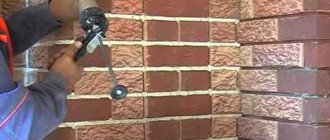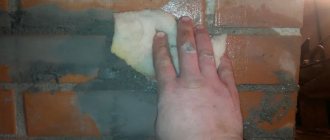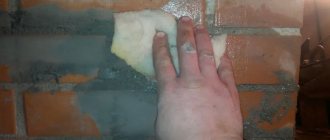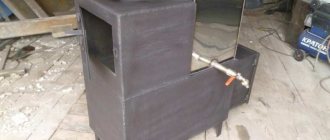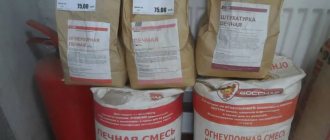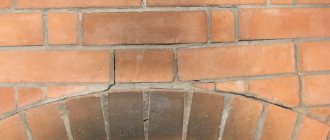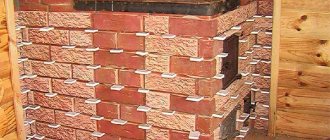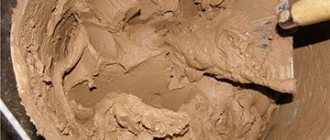Many owners of private houses are increasingly giving preference to such types of heating as gas or steam, and if there is central heating in the locality, some find it easier to connect to the heating network. However, in many houses the stove heating method is retained - both as the main source of heat and as an auxiliary one. Often the choice in favor of a conventional stove is associated with economic considerations - the best brick stove will cost less than laying a distribution pipeline to connect to central heating.
The stove is a fairly voluminous structure, making it invisible is almost impossible. Most often, red brick is used for masonry, which does not always look harmonious in the room. Therefore, the owners make efforts to ensure that the stove fits into the interior and looks neat. Furnace finishing is often done using plaster.
However, many are faced with this problem - after a few years, the plaster from a brick kiln begins to crumble. In fact, this can be avoided, the main thing is to do the plastering work correctly.
Why plaster the stove?
The answer to the question of when and why it is necessary to plaster a stove is very important. Having understood it, you can accurately decide whether this process is really necessary or whether decorative finishing from ceramic or fireclay tiles is sufficient.
There are several reasons that necessarily require plastering of surfaces:
- The stove was built a long time ago, and the old plaster was partially cracked and began to peel off. As a result, bare areas look unattractive.
- There is a risk of carbon monoxide leaking into the cracking masonry joints of an old stove.
- During the renovation process, it is necessary to change the style of the overall interior, as a result of which the stove needs to be given a more neat appearance or completely transformed.
- There was a need to treat the seams between the rows of bricks, in which settlements of various insects were found. This happens when solutions based on natural materials are used for laying the stove. Plastering the stove prevents the appearance and reproduction of insects.
- The masonry of the stove is not done carefully, which spoils the appearance of both the structure and the entire room. With the help of plaster you can completely solve a problem of this kind.
If we compare plaster with other types of finishing materials, we can note several advantageous points:
- Plastering is the simplest and most affordable way to put the stove in order.
- The mixture for plastering the surface is much cheaper compared to ceramic tiles or stove tiles. This allows you to significantly save material resources.
- The plaster mixture can be used to finish a newly built stove or to reconstruct an old building element.
- The applied layer of plaster makes the walls of the furnace thicker, therefore, the heat capacity coefficient of the structure increases. As a result, the furnace takes longer to cool down, resulting in reduced fuel costs.
- A plastered stove becomes less fire hazardous, and the risk of carbon monoxide entering the room is also reduced.
- After the plaster mixture has dried, you can use various materials to finish the oven. This can be water-based paint, lime mortar or decorative plaster.
The importance of plastering work
Furnace finishing options are not limited to just applying layers of plaster. The cladding is done using fireclay or ceramic tiles, decorative stone, metal elements, and is also completely abandoned if the “bare” stove masonry looks neat and stylish. However, plastering, which was practiced by our ancestors, has its advantages and practical benefits:
- correction of masonry defects;
- leveling the surface of the walls;
- protection from insects that make nests in the seams between bricks;
- preventing the release of carbon monoxide into the room through cracks and gaps in the finishing layer;
- reducing the risk of fire;
- increasing heat capacity, which allows you to heat a house using less fuel;
- safety during operation, since the surface of the oven does not heat up to temperatures that could harm people.
In addition, plastering is an affordable and low-cost process. It is also worth taking into account its versatility and flexibility in use. Plaster is effectively used in working with all types of stoves, from finishing from scratch to restoring old structures, and the possibilities of decoration are limited only by imagination.
Tools - how to plaster a stove in the house
The service life of a plastered surface largely depends on the adhesion of materials, and for this it is necessary to correctly apply the plaster and distribute it evenly on the surface of the stove.
You can solve the question of how to plaster a stove without cracking using special tools, which include the following:
- Putty knife. Several types of spatulas are used; with the help of some tools the solution is collected from a container, while with others it is applied to the surface.
- Plastering hammer. This tool is used to drive plaster nails.
- Trowel. Using this tool, the solution is evenly distributed on the stove wall.
- A hammer-cam is necessary for working with a chisel or a trojan.
- Scissors are ordinary and for cutting metal. If you use fiberglass mesh in the process, you will need ordinary scissors; you need to cut the chain-link mesh with metal scissors.
- A grater is necessary for leveling and smoothing a plastered stove wall.
- Using a smoother, the surface is brought to perfect smoothness.
- A chisel is used to make notches on the surface of the stove, this promotes better adhesion of the plaster and the working surface.
- Brushes. It is necessary to purchase several types of this tool, since some are used to apply primer, while others can be used to apply textured plaster.
- Using a building level, check the vertical and horizontal level of the working surface.
- Using a plumb line, the evenness of the walls and the applied plaster solution is controlled.
- As a rule, the mixture is distributed between beacons, which are installed on the walls for even plastering of the surface.
How and what to rub down a stove after plastering
At the moment when the plaster has already set, but has not yet completely dried, it should begin to be rubbed. A brush and grater will be useful for this process. A brush is used to soften the surface of the oven, and a grater is used to rub it. To do this, use a grater to make circular movements of a small radius. If the grater feels like it has reached a convex part of the surface, then the pressure on it increases to remove excess material. And if, on the contrary, it is on the depression, then the pressure should be loosened. Thanks to mashing, the stove acquires a smooth and aesthetically pleasing appearance.
Types of mortar for plastering stove walls
The stove is one of the building elements that regularly heats up and cools down, so the chosen plaster composition must be resistant to this phenomenon.
Mixtures for preparing plaster mortar are divided into two types:
- Simple compositions that include only two components, sand and clay.
- Complex formulations contain more than two ingredients.
Plastering a stove with clay and sand requires preliminary preparation and cleaning of the materials from various impurities. In particular, sand must be sifted through a fine sieve, clay should be rubbed through a fine mesh to remove roots and small stones.
It is recommended to make the plaster mixture using fatty types of clay, this promotes better adhesion of the solution to the surface. If the clay is too oily, the amount of sand used can be increased.
You need to know how to dilute clay for plastering a stove. To begin with, it should be soaked in a small amount of water and left for several hours, adding liquid in small portions if necessary. The process is repeated until a 10-15 cm layer of water remains above the clay. After mixing the finished clay mixture, the consistency of thick sour cream should be obtained.
In some cases, asbestos, finely chopped straw or fiberglass are added to the mixture for plastering the stove. These reinforcing components make it possible to obtain more durable materials.
When preparing plaster mixtures, special attention must be paid to the environmental side. During the heating process, the materials used should not emit substances that pose a danger to human health and life.
Separately, it should be said about salt; it is also sometimes added to the solution for plastering the stove. It should be noted that the opinion that salt makes it stronger can be considered erroneous. In fact, salt increases the hygroscopicity of clay, making it more flexible and resistant to cracking. Also, a plastering solution, to which a certain amount of salt is added, prevents the proliferation of various insects in masonry joints. For owners of private houses, this fact is of great importance.
Another component that can be added to the plaster mixture is gypsum powder. This material is used as a fixative. However, plaster must be used very carefully, as it hardens very quickly. The initial setting of the solution with the addition of gypsum powder occurs immediately after application, and after 10-15 minutes the surface hardens completely.
Adding lime along with gypsum makes the solution more durable and able to dry in a short time. But when choosing such mixtures, you should remember the properties of gypsum, so it is better to prepare a small portion immediately before plastering the stove. It is very important to understand that it is impossible to dilute the gypsum mixture with water.
Rules for preparing the solution
In order to achieve good results, close attention must be paid to the process of preparing the solution itself. In this case, it is necessary to follow a number of simple rules not only when mixing the plaster mixture, but also when preparing the components.
Clay:
- clear away debris;
- Place in water to soak for several days;
- filter the resulting slurry through a coarse sieve.
Soaking clay
Lime (work to prepare this material is carried out only outside):
- pour pieces of lime into a bucket (it should only be metal) - no more than half the volume of the bucket;
- fill with water (no more than 0.6 bucket volume);
- Allow the solution to cool overnight;
- drain the solution;
- pass the lime slurry through a coarse sieve.
Sand also needs to be sifted, asbestos or fiberglass must be thoroughly crushed.
Sifting sand
To prepare a high-quality solution, you need to reproduce the following sequence of actions:
- Sifted sand is mixed into the prepared clay.
- The remaining components of the solution (for example, fiberglass) are added.
- The solution is thoroughly mixed. This can be done using a drill, a construction mixer, or a hammer drill with a special attachment.
A high-quality solution should not contain solid particles or lumps; it looks homogeneous and plastic.
Ready-made solution for plastering the stove
There are a number of nuances associated with storage and use periods, depending on what solution it was decided to use:
If gypsum was used as a base, such a solution hardens very quickly. It must be prepared in small portions, which should be immediately applied to the stove;
The prepared solution with a cement base should be used within an hour after it has been diluted with water;
The clay-based mixture can be prepared in advance. It can be stored for a long time if the container is sealed.
How to plaster a brick stove with your own hands
You can finish the stove using plaster mortar yourself; you need to know how to properly plaster the stove and follow the sequence of actions.
Preparatory stage
The quality of plastering in most cases depends on how correctly the preparatory work on the surface is done. Good preparation of the stove walls is the key to better adhesion of the plaster mortar to the surface.
The preparation process involves performing the following actions:
- To reconstruct a stove or fireplace, it is necessary to remove old plaster from the surface using a chisel and hammer. Then the wall is cleaned of dust using a regular or iron brush.
- The newly built stove is cleaned of any remaining masonry mortar. Neglecting this step may cause poor adhesion of the plaster to the working surface. As a result, after some time the plaster will begin to lag behind the walls of the oven.
- After cleaning the surface, it is necessary to deepen the masonry joints. Moreover, this step is necessary both for the structure being restored and for a new stove. It is also recommended to remove dust from the seams.
- The next step is to apply a primer to the stove walls. It is best to work with a thin brush so that the buried seams are not left untreated.
- The process of plastering uneven walls should always be accompanied by surface reinforcement. To strengthen the furnace walls, a metal or fiberglass mesh with cells of 1.5 * 1.5 or 2 * 2 mm is used. Reinforcement helps strengthen the plaster on the surface, making it more resistant to temperature changes. The use of reinforcing materials makes it possible to apply a thick layer of plaster, thereby increasing the heat capacity of the furnace. To fix the metal mesh, use nails with a wide head. When using fiberglass mesh, you need to apply a thin layer of plaster to the wall, embed the mesh in it, apply additional mortar and level it. It is recommended to use fiberglass on walls with slight unevenness.
- To preserve or restore corners, it is recommended to use steel or perforated aluminum corners, which are attached to an adhesive solution.
- For large differences, surface evenness is achieved by installing beacons. They are fixed to a gypsum mortar, which allows you to carry out work almost without stopping. If you have enough free time, you can attach the beacons to the clay solution, but it is better to do this with the reinforcing mesh in close contact with the wall.
- The preparatory layer of plaster can be perfectly smooth or rough. The first option is used for whitewashing or painting, the second – for decorative relief plaster. It should be remembered that ceramic tiles and decorative plaster do not require a very thick preparatory layer.
Types of decorative plaster for stoves and fireplaces
For a long time, in order to ennoble a real Russian stove, it was customary to whitewash it. Whitewashing is still relevant in village houses, but in modern realities it is better to give preference to decorative plaster, which is divided into 4 main types:
- Acrylic. It contains acrylic resins, has relatively low vapor permeability and is well resistant to the harmful effects of the external environment.
- Mineral. The main component of such a mixture is cement. Just like acrylic, it is well protected from the external environment.
- Silicate. It is distinguished by the presence of liquid glass among the components. However, it has a small color palette available.
- Silicone. The plaster is based on silicone resins. It is more expensive than its analogues, but its cost is compensated by its high quality and excellent resistance to the external environment and dirt.
With its help, you can not only create an aesthetically pleasing covering on the fireplace, but also make decorative elements, for example, bas-reliefs, which will help stylize the stove or fireplace to match a certain style.
There is no definite answer as to which decorative plaster is definitely suitable for your stove or fireplace. This choice depends on many factors, including budget, but there is still one universal rule.
Regardless of how exactly the fireplace will be designed, it is important to remember that decorative plaster must have increased heat resistance.
If you have chosen mineral-based decorative plaster, then it is better to choose one with lime or clay as the connecting link. If the choice fell on acrylic, it is important to remember that its temperature limit is 90 degrees. You can also use decorative plasters based on silicate or silicone.
After work with decorative plaster is completed, the coating can be additionally painted or varnished to further give the fireplace or stove aesthetic and protective properties.
Applying plaster to the walls of the oven to prevent cracking
Before plastering the stove in the house, you need to familiarize yourself with the methods used.
Method No. 1 is most often used to level walls that have large distortions. In other words, when a layer thickness of 5-8 cm is required, the process proceeds as follows:
- They set up beacons that allow you to maximally level the surface with large differences. During the installation process, a building level is used, with its help you can achieve perfect evenness.
- Next, the stove is heated so that its walls are warm.
- Using a roller or wide brush, moisten the furnace wall with water to hammer fine dust and dry mortar into the masonry joints.
- The entire surface is covered with a primer and left until completely dry. Priming promotes good adhesion of the working solution to the surface.
- The first layer of plaster is applied using the sketch method; its thickness should not exceed 4-5 mm. In this case, the solution should not be very thick. Throwing the mortar must be accentuated in order to ensure that it gets into the seam between the bricks. After sketching the entire surface, leave the solution for plastering the stove until it dries.
- After this, they begin to apply the next layer; it should protrude 1 cm above the beacons. Work begins in the lower part of the oven, throwing the solution between the beacons to a height of 40-50 cm. By pressing the rule against the beacons, the applied mixture is leveled. After this, move on to the next section and repeat the entire process. Without waiting for the plaster to dry completely, grind the work surface using grout.
To prevent cracks from forming on the surface of the plaster layer during the drying process, stove makers with many years of experience advise covering the stove walls with damp burlap after applying the mixture for plastering the stove. If the fabric dries quickly, you can moisten it.
The burlap is removed from the dried surface, and the surface is rubbed and smoothed using a trowel with a rubber surface.
- For the third layer, it is necessary to prepare a more liquid solution for plastering the stove; its thickness should be 1.5-2 mm, since it is used to smooth the plastered surface. The third layer is applied only before painting or whitewashing.
- Making corners, even those reinforced with a metal corner, is considered a rather complicated process even for experienced craftsmen. To simplify the work, use an angled spatula. With this tool, the solution is easily applied and leveled well. If it is impossible to purchase such a spatula, use a wooden strip. It is fixed on one side of the corner and the solution is applied. After drying, the lath is removed and moved to the other side, and the solution is applied to the other side of the stove corner.
- In some cases, the edge of the corner is rounded. This makes it safer for small children and avoids chipping.
Method No. 2 of solving the question of how to plaster a stove with your own hands involves putting it in order using a metal mesh netting. This material is intended to reinforce the surface and give the required thickness to the plaster layer.
The surface is leveled as follows: pieces of wire no more than 25 mm thick are placed under the fixed metal mesh in the right places, hooking it onto the mesh or pre-installed metal slats.
The plaster is applied in several layers, similar to the first method, but the mesh must be completely covered with a plaster layer.
When applying the first layer, you should make sure that the solution passes through the oven plaster mesh and adheres to the wall. After spraying, the surface is left to dry. When the plaster dries, the mesh becomes motionless, so subsequent leveling layers are applied more easily and easily.
The last layer is leveled, allowed to dry, and the cracks that appear on the surface are covered and rubbed (read also: “How to cover up cracks on a stove - options for solving the problem”).
Finally, the decorative coating is installed.
Plastering stove walls in this way allows you to obtain a durable finish that is securely attached to the surface.
Method No. 3 is used for smooth stove walls that require minor cosmetic repairs, so the solution is applied once or twice, maintaining a total thickness of no more than 5-6 mm.
Surface preparation is carried out by analogy with the first methods, always applying a layer of primer for a brick oven.
It is allowed to use metal slats-beacons, which allow you to control the thickness of the plaster layer. However, when plastering smooth walls, guides do not need to be used.
The plaster mixture for cosmetic repairs of the furnace must contain fireclay clay and crushed asbestos. In this case, you can get a more durable solution and, accordingly, a high-quality finish.
It is best to apply the mixture for plastering stoves from the bottom up, using a wide spatula. It is best to level the plaster using a rule, pressing it against the metal slats. If they are absent, the solution is evenly distributed over the surface, checking the evenness using a building level.
It is also recommended to use a corner spatula to remove corners.
After applying the plaster mortar to the entire surface of the stove wall, carefully level it with grout.
This finish can serve as the basis for ceramic or fireclay tiles, as well as decorative relief plaster.
Carrying out preparatory work
Before plastering the stove with your own hands, you need to prepare the room in which it is located. To do this, you should remove unnecessary items from it, and cover all furniture with unnecessary fabric. To cover the floor, walls and windows, you should use polyethylene, which will serve as protection from dirt and damage. The following types of materials will be required for work:
- Cement composition.
- Mixture to plaster the stove.
- Mesh for surface reinforcement (mesh size 10x10 mm).
- Lime (paint), which is water-based.
Before plastering the stove yourself, it is recommended to familiarize yourself with the technology of this process, and also take care in advance to prepare all the necessary tools and materials:
- electric drills for mixing with a mixer attachment;
- brushes or spray to moisten the surface;
- scissors for fabric and metal;
- containers for water and plaster;
- coarse sieve for sand and clay;
- mixture scoops;
- pliers or wire cutters;
- trowel or trowel;
- chisel or spatula;
- pliers;
- hammer;
- graters;
- vacuum cleaner;
- broom
Before applying a fresh layer of plaster to the old stove, it is necessary to completely clean its surface from worn-out composition, removing it with a chisel or spatula. To completely level the surface, you should use the grouting method using sandpaper. This will eliminate minor errors.
Surface preparation involves removing dust and small debris with a vacuum cleaner or broom. Then you can decide what to plaster the stove with and how to prepare the mixture with the optimal composition. For many home craftsmen, the preferred option is to prepare a regular clay solution. Depending on the preferences of the stove owner, soft, rough plaster or a mixture with a mother-of-pearl effect can be used. A fire-resistant mortar usually has a more complex composition than a simple mixture.
Decorative finishing
The decorative design of the stove walls is carried out in accordance with the taste preferences of the owner. An evenly plastered surface can simply be whitewashed; by the way, whitewashing is a traditional finishing method that has been used since ancient times. The whitewashed surface was often painted with imported paints, giving the room originality and emphasizing national traditions. In most cases, the ornament was selected according to local traditions.
Modern technologies and materials make it possible to create an imitation of natural stone or a uniform relief structure on the surface of the stove wall.
Quite often, craftsmen with a wide imagination decorate stoves with elements of three-dimensional designs, using various available means for this purpose. In particular, we are talking about plastic film, brushes, brushes and other materials and objects.
Creative people create relief compositions from decorative plaster, allowing them to protrude slightly beyond the stove walls. Subsequently, all this is covered with paints. Moreover, applying the coloring composition to wet decorative plaster promotes deeper penetration and increases the service life of the decorative finish.
In some cases, the dried surface is additionally painted, which allows for a brighter design.
Terracotta or ceramic tiles can be used as decorative finishing for stove walls. The additional purchase of corner finishing elements makes the installation of tiles and decoration simpler and more convenient, allowing you to obtain neat and aesthetic corners. The tiles are installed using a special cement-based adhesive composition, which is resistant to temperature changes.
Photos of stoves and fireplaces finished with decorative plaster
To accurately determine whether decorative plaster is suitable for you as a finish for your stove or fireplace, it makes sense to look at examples of finished work done in different styles.
craquelure plaster with cracksTyutyunnikov Dmitry
Article verified by a decorative finishing specialist
Some subtleties of plastering a stove with a mixture of sand and clay
When plastering stoves with your own hands, it is important to take into account several main points, on which the quality of the work largely depends:
- It is not recommended to plaster a newly erected stove. The structure must go through the drying and shrinking stage. For this purpose, the stove must be heated regularly for 2-3 months, after which finishing work can begin.
- It is best to paint plastered stove walls with water-based paints. The use of other formulations may cause the release of harmful substances and unpleasant odors.
- All materials used to decorate stove walls must have a natural base so as not to pose a danger to human health.
All the methods described for plastering a stove cannot be called simple for independent use. Therefore, in the absence of initial knowledge and experience, it is better to entrust the plastering of a brick stove to professional craftsmen. In this case, you can get a high-quality result and avoid unnecessary consumption of materials.
Preparing the base
- First of all, the surface of the stove must be clean, and the old lining must be completely removed from it. Plus, to improve the adhesion of the finish to the base, you should clean the seams between the bricks to a depth of 5 mm.
- If it is possible to control the process of laying the structure, then burnt steel wire can be immediately placed in the seams between the bricks. Subsequently, it will be useful for attaching steel reinforcing mesh.
- If the structure is new, then you need to let it settle for at least 1 month. Volumetric structures can shrink up to 1 year. Otherwise, the brick oven plaster, after shrinking, will crack or even fall off. Moreover, all this time the oven must be heated regularly and well.
Prepared base.
The final stage is decoration.
You don’t have to create any difficulties for yourself and buy ready-made paint, the main thing is that it is designed specifically for fireplaces and stoves. Water-based dyes are suitable. If you cover the stove with one color, it will have a neat appearance. Do you want something sophisticated? Choose several colors that go well together and paint them. This work must be done before the surface is completely dry, that is, the plaster should be a little damp.
However, in the villages they don’t think about what can be used to paint the stove after plastering, but simply apply lime milk, add table salt to it, mix and apply the resulting solution to the plastered surface. The lime composition has a distinct advantage: after drying, it does not stain hands and objects.
An alternative option is to finish the surface with smooth or embossed decorative plaster.
What about fireplaces?
Unlike a stove, which accumulates heat in its mass, a fireplace is a less heat-intensive heating device. Heating of the room in an open fireplace occurs mainly due to radiation. A warm fireplace gives off its heat as long as the wood is burning and only a small part of the heat accumulates in the walls of the firebox. As a rule, country houses are chosen to install fireplaces, but in some cases this can be done in a city apartment.
Installing fireplaces in an apartment is associated with significant difficulties and the need to obtain permits, as well as the complexity of the work, and therefore its high cost.
They arise against the background of the requirements imposed by the relevant services for such apartments. Serious difficulties may arise due to the need to redevelop the premises, as a result of which the fireplace may be moved to a new location with the need to equip a new chimney and lay down the old one. Connecting a fireplace also depends on the design features of a particular house, the ability to withstand the weight of the fireplace, otherwise it will be necessary to create a solid foundation for the fireplace and chimney or reinforce the interfloor ceilings. HomeSitemap
How to plaster a stove - step-by-step instructions
Plastering a stove with clay is like a whole ritual from ancient times. This is not surprising, the operating conditions of the stove are the most difficult in the house, so it needs much more attention than other furnishings. Before plastering the stove, prepare all the necessary tools and materials: a wooden grater, a container and a spatula for mixing, reinforcement materials, and mortar components.
Types of plaster mesh
Reinforced mesh for plaster differs in the materials used for its production, the structure and size of the cells, and the methods of creation. According to the first criterion, the following varieties are distinguished:
Products have all the advantages and disadvantages of the materials used to produce them.
A more detailed classification is presented in the table below.
| View | Cell size, mm | Characteristic |
| masonry (painting) | 5*5 | plastic sheet used when working outside and inside buildings using gypsum mixtures |
| universal: small, medium, large | 6*6, 14*15, 22*35 | the fine-mesh version is a suitable mesh for plastering internal walls, and the coarse-mesh version can withstand temperature changes and external loads well |
| fiberglass mesh | 5*5 | durable, resistant to moisture, cold and heat, chemical compounds |
| Plurima | 5*6 | made from polypropylene, chemically inert, used for external and internal work |
The existing assortment allows you to select high-quality products taking into account all requirements. The use of a material that meets existing conditions determines the durability of the finish.
Fire protection of adjacent areas
Lining the firebox with bricks in a bathhouse is good protection against fire
The finishing of a sauna stove, as well as the design of fireplaces and stoves in other rooms with wooden surfaces, necessarily involves the installation of protective structures. Their need is quite obvious: the walls of the stove, especially those made of metal, become very hot, and therefore any contact with a flammable material (and wood, even if impregnated with antipyretics, still remains flammable) can lead to a fire.
To solve this problem, you can use a variety of heat-resistant materials to decorate the walls near the stove. I will briefly describe the most popular products in the table below:
Fastening mineralite with screws with bushings
| Material | Features of use |
| The easiest way to protect wooden walls from fire is to build a false wall made of refractory bricks around the stove in a bathhouse or other room. Building stone tolerates heat well and absorbs heat, therefore, in addition to fire protection, it can also act as an additional heat accumulator. |
| Plasterboard sheets lined with natural stone or porcelain stoneware are also a good solution for preventing fire. Fire-resistant plasterboard itself, of course, cannot resist prolonged exposure to very high temperatures, but together with stone cladding it forms a fairly reliable screen. |
| Non-asbestos material produced by the Finnish company Cembrit Oy. Minerite sheets are attached to the wall with screws, and if the stove is closer than 50 cm to the wall, then using ceramic bushings we create a 3 cm gap between the wood and the mineralite. |
| The polished steel screen protects the wall well primarily due to its reflective ability. Naturally, such a screen is mounted not on the tree itself, but on a substrate made of non-flammable material - basalt wool, asbestos sheet, the already mentioned mineralite, etc. |
Expert advice on repairs
The stages of finishing the stove wall are identical for any selected mass. The differences are insignificant, but they are taken into account during the plastering process.
So the composition with the introduction of gypsum will dry 2 times faster than with cement. The use of fireclay clay in bulk is well suited for laying on bricks of the same composition, since the thermal conductivity is the same.
The plastered structure must dry without using auxiliary means.
More than one master will not answer how best to finish a stove building. Each stove maker has his own secrets and components of solutions for plastering brick surfaces. You can knead a clay and sand mixture and buy a ready-made mass. It is important to correctly connect and apply the material to the walls of the heated structure.
Ready mixes
Plaster can withstand high temperatures for a long time, does not crack or crumble.
The building materials market is filled with various types of fire-resistant products that allow you to plaster stoves yourself. The most popular, well-deservedly recognized, are the heat-resistant compositions “Fireproof”, “Terracotta”, “Pechnik”.
“Fireproof” mixture, available in three modifications:
- smooth plaster;
- simulated mixture;
- composition for tiled surfaces.
When using a modeled variety, it is possible to obtain a textured surface onto which any pattern can be easily applied. The smooth composition is ideal for painting most stoves.
“Terracotta” is another dry mixture, which includes clay and fine fireclay sand with fireproof additives. The solution is intended for treating surfaces made of ceramic and fireclay bricks and can withstand heating temperatures up to 200 ºC.
The composition called “Kilnmaker” includes lime and sand, as well as gypsum, cement, asbestos and clay.
Repair of stove plaster
If cracks do appear on the stove coating, this means a violation of the plastering technology or improper operation of the structure (overheating, loosening of doors, etc.). In difficult cases, you will have to reposition the stove, but most often, “cosmetic” repairs help. The work is carried out in the following sequence:
- Completely remove old plaster and whitewash from the surface of the damaged area, remove soot, otherwise the latter will appear from under the layer of mortar in the form of rusty spots.
- Cracked bricks are restored with a special repair mixture or the cracks are filled with heat-resistant mastic. If repairs are impossible, the bricks are replaced with new ones, but plastering begins no earlier than after 7 days.
- Apply the primer with a brush and let it dry.
- Prepare the plaster composition and apply it to the area moistened with water by throwing it on. After leveling the solution, rub it with a construction trowel.
- Loose doors are reinforced with wire, and a clay composition is also applied around the fastening area. Let the stove dry.
If the plaster is made correctly, finishing the stove or repairing it can be done with your own hands. The costs of such work will be small, and the savings on wages for invited craftsmen will be significant.
